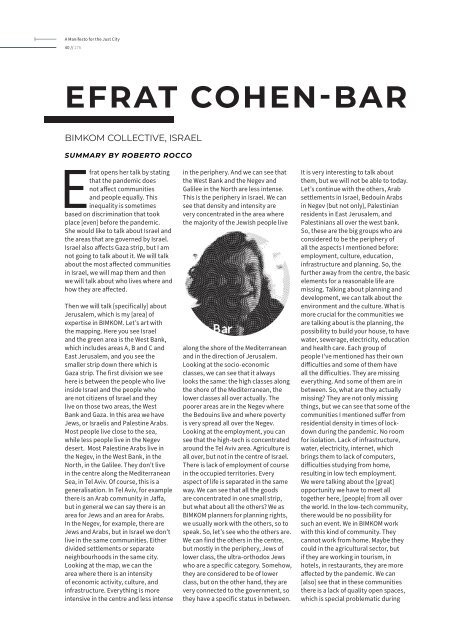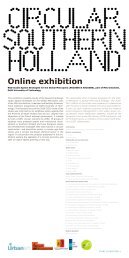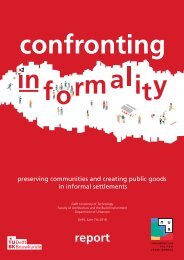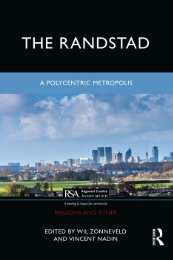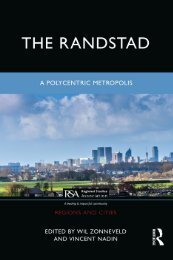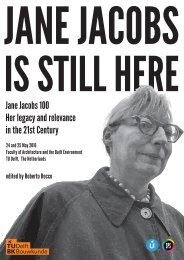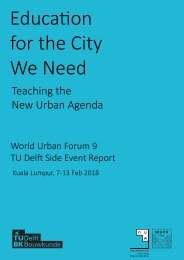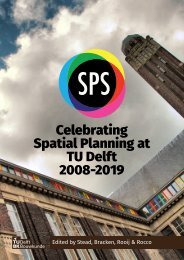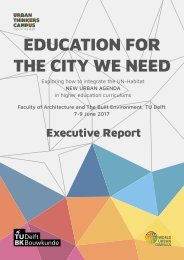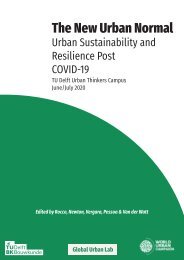A Manifesto for the Just City
On Monday 29 MARCH at 18:00 (CET/Amsterdam), TU Delft launched the Book "A Manifesto for the Just City", with texts by a number of guests and 43 manifestos written by students from 25 universities from all over the world. A “Manifesto for the Just City” comes in the wake of the realisation that socio-spatial justice is a crucial dimension for sustainability transitions. Growing inequality and the erosion of the public sphere undermine the social and political structures required to fight climate change, pandemics and other systemic shocks. With this book, we have sought to encourage students to formulate their own visions for the Just City and for a just transition. This book is result of an Urban Thinkers Campus organised between 9 and 30 November 2020. The Urban Thinkers Campus (UTC) model is an initiative of UN-Habitat’s World Urban Campaign, conceived in 2014 as an open space for critical exchange between stakeholders and partners. It aims to promote debate and action on sustainable and inclusive urbanization upholding the principles and guidelines contained in the New Urban Agenda, launched at Habitat-III in 2016 in Quito, Ecuador.
On Monday 29 MARCH at 18:00 (CET/Amsterdam), TU Delft launched the Book "A Manifesto for the Just City", with texts by a number of guests and 43 manifestos written by students from 25 universities from all over the world.
A “Manifesto for the Just City” comes in the wake of the realisation that socio-spatial justice is a crucial dimension for sustainability transitions. Growing inequality and the erosion of the public sphere undermine the social and political structures required to fight climate change, pandemics and other systemic shocks. With this book, we have sought to encourage students to formulate their own visions for the Just City and for a just transition.
This book is result of an Urban Thinkers Campus organised between 9 and 30 November 2020. The Urban Thinkers Campus (UTC) model is an initiative of UN-Habitat’s World Urban Campaign, conceived in 2014 as an open space for critical exchange between stakeholders and partners. It aims to promote debate and action on sustainable and inclusive urbanization upholding the principles and guidelines contained in the New Urban Agenda, launched at Habitat-III in 2016 in Quito, Ecuador.
Create successful ePaper yourself
Turn your PDF publications into a flip-book with our unique Google optimized e-Paper software.
A <strong>Manifesto</strong> <strong>for</strong> <strong>the</strong> <strong>Just</strong> <strong>City</strong><br />
40 // 276<br />
EFRAT COHEN-BAR<br />
BIMKOM COLLECTIVE, ISRAEL<br />
SUMMARY BY ROBERTO ROCCO<br />
Efrat opens her talk by stating<br />
that <strong>the</strong> pandemic does<br />
not affect communities<br />
and people equally. This<br />
inequality is sometimes<br />
based on discrimination that took<br />
place [even] be<strong>for</strong>e <strong>the</strong> pandemic.<br />
She would like to talk about Israel and<br />
<strong>the</strong> areas that are governed by Israel.<br />
Israel also affects Gaza strip, but I am<br />
not going to talk about it. We will talk<br />
about <strong>the</strong> most affected communities<br />
in Israel, we will map <strong>the</strong>m and <strong>the</strong>n<br />
we will talk about who lives where and<br />
how <strong>the</strong>y are affected.<br />
Then we will talk [specifically] about<br />
Jerusalem, which is my [area] of<br />
expertise in BIMKOM. Let’s art with<br />
<strong>the</strong> mapping. Here you see Israel<br />
and <strong>the</strong> green area is <strong>the</strong> West Bank,<br />
which includes areas A, B and C and<br />
East Jerusalem, and you see <strong>the</strong><br />
smaller strip down <strong>the</strong>re which is<br />
Gaza strip. The first division we see<br />
here is between <strong>the</strong> people who live<br />
inside Israel and <strong>the</strong> people who<br />
are not citizens of Israel and <strong>the</strong>y<br />
live on those two areas, <strong>the</strong> West<br />
Bank and Gaza. In this area we have<br />
Jews, or Israelis and Palestine Arabs.<br />
Most people live close to <strong>the</strong> sea,<br />
while less people live in <strong>the</strong> Negev<br />
desert. Most Palestine Arabs live in<br />
<strong>the</strong> Negev, in <strong>the</strong> West Bank, in <strong>the</strong><br />
North, in <strong>the</strong> Galilee. They don’t live<br />
in <strong>the</strong> centre along <strong>the</strong> Mediterranean<br />
Sea, in Tel Aviv. Of course, this is a<br />
generalisation. In Tel Aviv, <strong>for</strong> example<br />
<strong>the</strong>re is an Arab community in Jaffa,<br />
but in general we can say <strong>the</strong>re is an<br />
area <strong>for</strong> Jews and an area <strong>for</strong> Arabs.<br />
In <strong>the</strong> Negev, <strong>for</strong> example, <strong>the</strong>re are<br />
Jews and Arabs, but in Israel we don’t<br />
live in <strong>the</strong> same communities. Ei<strong>the</strong>r<br />
divided settlements or separate<br />
neighbourhoods in <strong>the</strong> same city.<br />
Looking at <strong>the</strong> map, we can <strong>the</strong><br />
area where <strong>the</strong>re is an intensity<br />
of economic activity, culture, and<br />
infrastructure. Everything is more<br />
intensive in <strong>the</strong> centre and less intense<br />
in <strong>the</strong> periphery. And we can see that<br />
<strong>the</strong> West Bank and <strong>the</strong> Negev and<br />
Galilee in <strong>the</strong> North are less intense.<br />
This is <strong>the</strong> periphery in Israel. We can<br />
see that density and intensity are<br />
very concentrated in <strong>the</strong> area where<br />
<strong>the</strong> majority of <strong>the</strong> Jewish people live<br />
along <strong>the</strong> shore of <strong>the</strong> Mediterranean<br />
and in <strong>the</strong> direction of Jerusalem.<br />
Looking at <strong>the</strong> socio-economic<br />
classes, we can see that it always<br />
looks <strong>the</strong> same: <strong>the</strong> high classes along<br />
<strong>the</strong> shore of <strong>the</strong> Mediterranean, <strong>the</strong><br />
lower classes all over actually. The<br />
poorer areas are in <strong>the</strong> Negev where<br />
<strong>the</strong> Bedouins live and where poverty<br />
is very spread all over <strong>the</strong> Negev.<br />
Looking at <strong>the</strong> employment, you can<br />
see that <strong>the</strong> high-tech is concentrated<br />
around <strong>the</strong> Tel Aviv area. Agriculture is<br />
all over, but not in <strong>the</strong> centre of Israel.<br />
There is lack of employment of course<br />
in <strong>the</strong> occupied territories. Every<br />
aspect of life is separated in <strong>the</strong> same<br />
way. We can see that all <strong>the</strong> goods<br />
are concentrated in one small strip,<br />
but what about all <strong>the</strong> o<strong>the</strong>rs? We as<br />
BIMKOM planners <strong>for</strong> planning rights,<br />
we usually work with <strong>the</strong> o<strong>the</strong>rs, so to<br />
speak. So, let’s see who <strong>the</strong> o<strong>the</strong>rs are.<br />
We can find <strong>the</strong> o<strong>the</strong>rs in <strong>the</strong> centre,<br />
but mostly in <strong>the</strong> periphery, Jews of<br />
lower class, <strong>the</strong> ultra-orthodox Jews<br />
who are a specific category. Somehow,<br />
<strong>the</strong>y are considered to be of lower<br />
class, but on <strong>the</strong> o<strong>the</strong>r hand, <strong>the</strong>y are<br />
very connected to <strong>the</strong> government, so<br />
<strong>the</strong>y have a specific status in between.<br />
It is very interesting to talk about<br />
<strong>the</strong>m, but we will not be able to today.<br />
Let’s continue with <strong>the</strong> o<strong>the</strong>rs, Arab<br />
settlements in Israel, Bedouin Arabs<br />
in Negev (but not only), Palestinian<br />
residents in East Jerusalem, and<br />
Palestinians all over <strong>the</strong> west bank.<br />
So, <strong>the</strong>se are <strong>the</strong> big groups who are<br />
considered to be <strong>the</strong> periphery of<br />
all <strong>the</strong> aspects I mentioned be<strong>for</strong>e:<br />
employment, culture, education,<br />
infrastructure and planning. So, <strong>the</strong><br />
fur<strong>the</strong>r away from <strong>the</strong> centre, <strong>the</strong> basic<br />
elements <strong>for</strong> a reasonable life are<br />
missing. Talking about planning and<br />
development, we can talk about <strong>the</strong><br />
environment and <strong>the</strong> culture. What is<br />
more crucial <strong>for</strong> <strong>the</strong> communities we<br />
are talking about is <strong>the</strong> planning, <strong>the</strong><br />
possibility to build your house, to have<br />
water, sewerage, electricity, education<br />
and health care. Each group of<br />
people I’ve mentioned has <strong>the</strong>ir own<br />
difficulties and some of <strong>the</strong>m have<br />
all <strong>the</strong> difficulties. They are missing<br />
everything. And some of <strong>the</strong>m are in<br />
between. So, what are <strong>the</strong>y actually<br />
missing? They are not only missing<br />
things, but we can see that some of <strong>the</strong><br />
communities I mentioned suffer from<br />
residential density in times of lockdown<br />
during <strong>the</strong> pandemic. No room<br />
<strong>for</strong> isolation. Lack of infrastructure,<br />
water, electricity, internet, which<br />
brings <strong>the</strong>m to lack of computers,<br />
difficulties studying from home,<br />
resulting in low tech employment.<br />
We were talking about <strong>the</strong> [great]<br />
opportunity we have to meet all<br />
toge<strong>the</strong>r here, [people] from all over<br />
<strong>the</strong> world. In <strong>the</strong> low-tech community,<br />
<strong>the</strong>re would be no possibility <strong>for</strong><br />
such an event. We in BIMKOM work<br />
with this kind of community. They<br />
cannot work from home. Maybe <strong>the</strong>y<br />
could in <strong>the</strong> agricultural sector, but<br />
if <strong>the</strong>y are working in tourism, in<br />
hotels, in restaurants, <strong>the</strong>y are more<br />
affected by <strong>the</strong> pandemic. We can<br />
[also] see that in <strong>the</strong>se communities<br />
<strong>the</strong>re is a lack of quality open spaces,<br />
which is special problematic during


